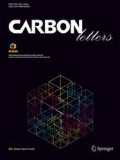Abstract
We studied trichloroethylene (TCE) adsorption from aqueous solutions in equilibrium conditions by activated carbons (AC). They differ in raw materials, porous structure characteristics and chemical state of the surface. TCE adsorption isotherms were found to have a concave shape, which is characteristic of a sorbent—sorbate weak interaction. It can be a result from electrostatic repulsion of organic matter molecule from polar groups on carbon surface and adsorbed water molecules. The basic parameters of adsorption were calculated by the Dubinin–Radushkevich equation. We determined that for AG-OV-1 and SKD-515 in the coordinates of the Dubinin–Radushkevich equation, there are two linear plots suggesting adsorption in pores of different sizes or reorientation of adsorbate molecules on the activated carbon surface. The efficiency of TCE removal by the activated carbons was evaluated. To reduce the TCE to the maximum allowable, the lowest sorbent consumption was observed for AC with the highest values of surface area and micropore volume. However, the high cost and hydrophobicity of these adsorbents make it impractical to use them in adsorption columns with a fixed layer. We offered an adsorbent that reasonably combines extraction efficiency, ease of operation and economic feasibility.





Similar content being viewed by others
Abbreviations
- °C:
-
Degree celsium
- μmol:
-
Micromol
- mmol:
-
Millimol
- mg:
-
Milligram
- ml:
-
Millilier
- nm:
-
Nanometer
- C 0 :
-
Initial trichloroethylene concentration (mmol/l)
- C b :
-
Breakage trichloroethylene concentration (mmol/l)
- C e :
-
Equilibrium trichloroethylene concentration (mmol/l)
- C s :
-
Solubility (mmol/l)
- E :
-
Characteristic adsorption energy (J/mol)
- q 0 :
-
Adsorption capacity limit (mmol/g)
- q :
-
Trichloroethylene adsorption (mmol/g)
- q b :
-
Specific capacity of the adsorbent to breakage (mmol/g)
- m :
-
Sorbent mass (g)
- m e :
-
Dose of sorbent (g/l)
- S BET :
-
BET surface area (m2/g)
- V :
-
Solution volume (l)
- W 0 :
-
Adsorption space limit (cm3/g)
- AC:
-
Activated carbon
- AST:
-
Average thickness of the adsorption layer (nm)
- COC:
-
Chlorinated organic compounds
- TVFM:
-
Theory of volume filling of micropores
References
Kirichenko VE, Pervova MG, Pashkevich KI (2002) Organohalogen compounds in potable water and methods of their determination. Zhurnal Ros. Khim. Obshchestva Im. D.I. Mendeleeva 46(4):18–28 (in Russian)
US EPA fact sheets (2019) http://nlquery.epa.gov/epasearch/epasearch. Accessed 18 July 2019
World Health Organization (2005) Trichloroethene in drinking-water background document for development of WHO Guidelines for Drinking-water Quality. https://www.who.int/water_sanitation_health/dwq/chemicals/trichloroethenemay05.pdf. Accessed 18 July 2019
Trichloroethylene: part 1 (Environment). In: ECB (European Chemicals Bureau), European union risk assessment report: vol. 31, European Commission (2004). https://echa.europa.eu/documents/10162/83f0c99f-f687-4cdf-a64b-514f1e26fdc0. Accessed 18 July 2019
Dobaradaran S, Nabizadeh R, Mahvi AH, Noroozi A, Yunesian M, Rastkari N, Nazmara S, Zarei S (2012) Kinetic and degradation efficiency of trichloroethylene (TCE) via photochemical process from contaminated water. Afr J Biotechnol 11(8):2006–2012. https://doi.org/10.5897/AJB11.3276
Nickelsen MG, Cooper WJ, Secker DA, Rosocha LA, Kurucz CN, Waite TD (2002) Kinetic modeling and simulation of PCE and TCE removal in aqueous solutions by electron-beam irradiation. Radiat Phys Chem 65(4–5):579–587. https://doi.org/10.1016/s0969-806x(02)00362-6
Urano K, Yamamoto E, Tonegawa M, Fujie K (1991) Adsorption of chlorinated organic compounds on activated carbon from water. Water Res 25(12):1459–1464
Karanfil T, Dastgheib S (2004) Trichloroethylene adsorption by fibrous and granular activated carbons: aqueous phase, gas phase, and water vapour adsorption studies. Environ Sci Technol 38:5834–5841
Pelech R, Bembnowska A, Milchert E (2003) Adsorption of hydrocarbon chloroderivatives onto DTO commercial carbon from multi-component aqueous solutions. Adsorpt Sci Technol 21(8):707–720
Naghizadeh A, Nasseri S, Nazmara Sh (2011) Removal of trichloroethylene from waterby adsorption on to multiwall carbon nanotubes. Iran J Environ Health Sci Eng 8(4):317–324
Hawley HA, Bergendahl J, Thompson R (2013) An equilibrium study on trichloroethylene adsorption and desorption from ZSM-5 in water. Energy Environ Eng 1(1):5–9. https://doi.org/10.13189/eee.2013.010102
Li L, Quinlivan P, Knappe DR (2002) Effects of activated carbon surface chemistry and pore structure on the adsorption of organic contaminants from aqueous solution. Carbon 40:2085–2100
Bansal RC, Donnet JB, Stoeckli F (1988) Active carbon. Markel Dekker, New York
Yang RT (2003) Adsorbents: fundamentals and applications. Wiley Interscience, Hoboken, pp 87–88
https://www.thomasnet.com/articles/chemicals/producing-activated-carbon. Accessed 18 July 2019
http://carbonrus.com/coals. Accessed 18 July 2019
Dubinin MM, Nikolaev KM, Petukhova GA, Polyakov NS (1991) Water vapor adsorption and microporous structure of carbon adsorbents. 18. Effect of surface chemistry of activated carbons on water vapor adsorption. Bull Acad Sci USSR Div Chem Sci 40(1):24–28
Petukhov VN, Girevaya KY, Kubak DA, Girevoy TA (2013) Interaction of the coal surface with water. Coke Chem 56(8):292–298
Nevskaia DM, Castillejos-Lopez E, Guerrero-Ruiz A (2004) Effect of the surface chemistry of carbon materials on the adsorption of phenol–aniline mixture from water. Carbon 42:653–665
Derylo-Marczevska A, Goworek J, Swiatkovski A (2004) Influence of difference in porous structure within granules of activated carbons on adsorption of aromatic from aqueous solutions. Carbon 42:301–306
Radovic LR, Silva IF, Ume JI (1997) An experimental and theoretical study of the adsorption of aromatic possessing electron-withdrawing and electron-donating functional groups by chemically modified activated carbons. Carbon 35(9):1339–1348
Vidic RD, Tessmer CH, Uranowski LJ (1997) Impact of surface properties of activated carbons on oxidative coupling of phenolic compounds. Carbon 35(9):1349–1359
Koganovskii AM, Klimenko NA et al (1990) Adsorption of organic substances from water. Khimiya Publ, Leningrad (in Russian)
Parfitt GD, Rochester CH (1983) Adsorption from solution at the solid/liquid interface. Academic Press Publications, London
Acknowledgements
The research was carried out in the framework of ‘Initiative scientific projects’ 19.4713.2017/БЧ state task.
Author information
Authors and Affiliations
Corresponding author
Additional information
Publisher's Note
Springer Nature remains neutral with regard to jurisdictional claims in published maps and institutional affiliations.
Rights and permissions
About this article
Cite this article
Krasnova, T.A., Belyaeva, O.V., Gorelkina, A.K. et al. Trichloroethylene adsorption from aqueous solutions by activated carbons. Carbon Lett. 30, 281–287 (2020). https://doi.org/10.1007/s42823-019-00096-y
Received:
Revised:
Accepted:
Published:
Issue Date:
DOI: https://doi.org/10.1007/s42823-019-00096-y




